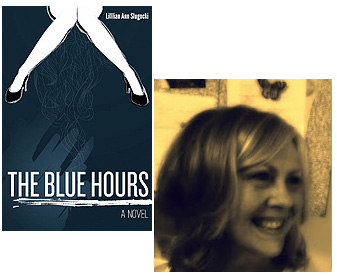Lillian Ann Slugocki: The Mythic Arc of The Blue Hours
 I met Lillian Ann Slugocki in 2001, shortly after she and Erin Cressida Wilson had published The Erotica Project, a series of monologues that they’d co-written for various theatrical and print formats. I’ve stayed in touch with Lillian over the years, so I was delighted recently to hear that she’d taken the plunge into digital publishing with The Blue Hours, a Newtown Press ebook for the Amazon Kindle that has its origins in a serial she wrote for Salon shortly after the success of the Project. In this essay, Lillian talks about the challenges of expanding the story well beyond its original size, and the dramatic solution she found to give the novella its final shape.
I met Lillian Ann Slugocki in 2001, shortly after she and Erin Cressida Wilson had published The Erotica Project, a series of monologues that they’d co-written for various theatrical and print formats. I’ve stayed in touch with Lillian over the years, so I was delighted recently to hear that she’d taken the plunge into digital publishing with The Blue Hours, a Newtown Press ebook for the Amazon Kindle that has its origins in a serial she wrote for Salon shortly after the success of the Project. In this essay, Lillian talks about the challenges of expanding the story well beyond its original size, and the dramatic solution she found to give the novella its final shape.
When Diary of a Divorce, a series of short erotic stories, debuted on Salon, it got quite a bit of attention from editors at major publishing houses. Which was great. I got to work expanding 10,000 words to 60,000. Except I really didn’t have a strategy.
This was my first foray into fiction writing; prior to this, I’d written plays. I was still flush from the success of The Erotica Project, co-authored with Erin Cressida Wilson. I kept the diary format, but really didn’t invent an arc for the story. It’s not surprising that when it was submitted to these editors, some of them said, “This reads like a memoir not a novel, make it more like a memoir.” And some said, “If this is a novel, it needs more narrative tension.” I tried to please all the editors, both camps, and I don’t think this ever ends well for any writer. When I walked away from it, I simply didn’t know if it was really memoir or fiction, or fictionalized memoir. So I put the “diary” away for a very long time.
Last fall, I was reading The Writer’s Journey by Christopher Vogler. It’s geared towards screenwriters, and the classic three act structure. But since he draws on Joseph Campbell’s The Hero with a Thousand Faces, I knew, obviously, this is one of the classic narrative structures, practically a template, maybe the only template for telling a story.
I had fallen in love with narrative structure while getting an MA at The Gallatin School. In particular I loved V. Propp’s Morphology of the Folktale Like Vogler and Campbell, he distills story telling down to its purest, simplest forms. I was doing all this research because I was writing another book, Scheherazade. I became convinced that despite the fact that the hero is almost a universally male narrative, I could still subvert it, twist it, use for my own purposes—a female narrative.
When I had that book all mapped out, I suddenly realized that this strategy would be perfect for Diary of a Divorce. I hadn’t thought of the piece in a long time, but it always haunted me. I knew there was a great story in there somewhere, and here was the mechanism for teasing it out.
First I ruthlessly edited out everything that didn’t contribute to the arc I now envisioned. I didn’t care how beautifully it was written, how true or not true it was to the source material, how much I loved it. Cut, cut, cut. And in its place, the protagonist of The Blue Hours started to tell her story. Tense was also a huge issue. In the first round, the story snapped back and forth from present to past. I anchored it firmly in the present. Point of view was next—if the narrative begins with the wife writing to her husband, that must remain consistent throughout. Then it became clear to me that she writes about all the things that she’s afraid to say to him. She writes about all the men she is sleeping with, while still sleeping with him. She writes about her doubt, her desire and her fear, but withholds all this information from him until the end of the story.
Within this framework, all traces of memoir disappeared. The protagonist’s series of one night stands before, during and after her divorce becomes a negotiation of identity, when identity is in flux, or even in danger of imploding. And her frank sexuality, heightened, exaggerated, mythologized, becomes the vehicle for her transformation.
The hero’s journey, on many levels, is remarkably simple: the hero perceives a problem, resists the knowledge that she must fix the problem, descends down or goes out into the world, does battle to fix the problem, and returns home, equilibrium restored. Whatever was missing from this arc, I wrote new material, imagined greater obstacles, more raw emotions, bigger arguments. In real life, the end of one thing, in this case, a marriage, and the beginning of something else is rarely a clean line in the sand. But in the world of story-telling, it can be a beautiful thing.
27 August 2012 | guest authors |

 Our Endless and Proper Work is my new book with Belt Publishing about starting (and sticking to) a productive writing practice.
Our Endless and Proper Work is my new book with Belt Publishing about starting (and sticking to) a productive writing practice. 
